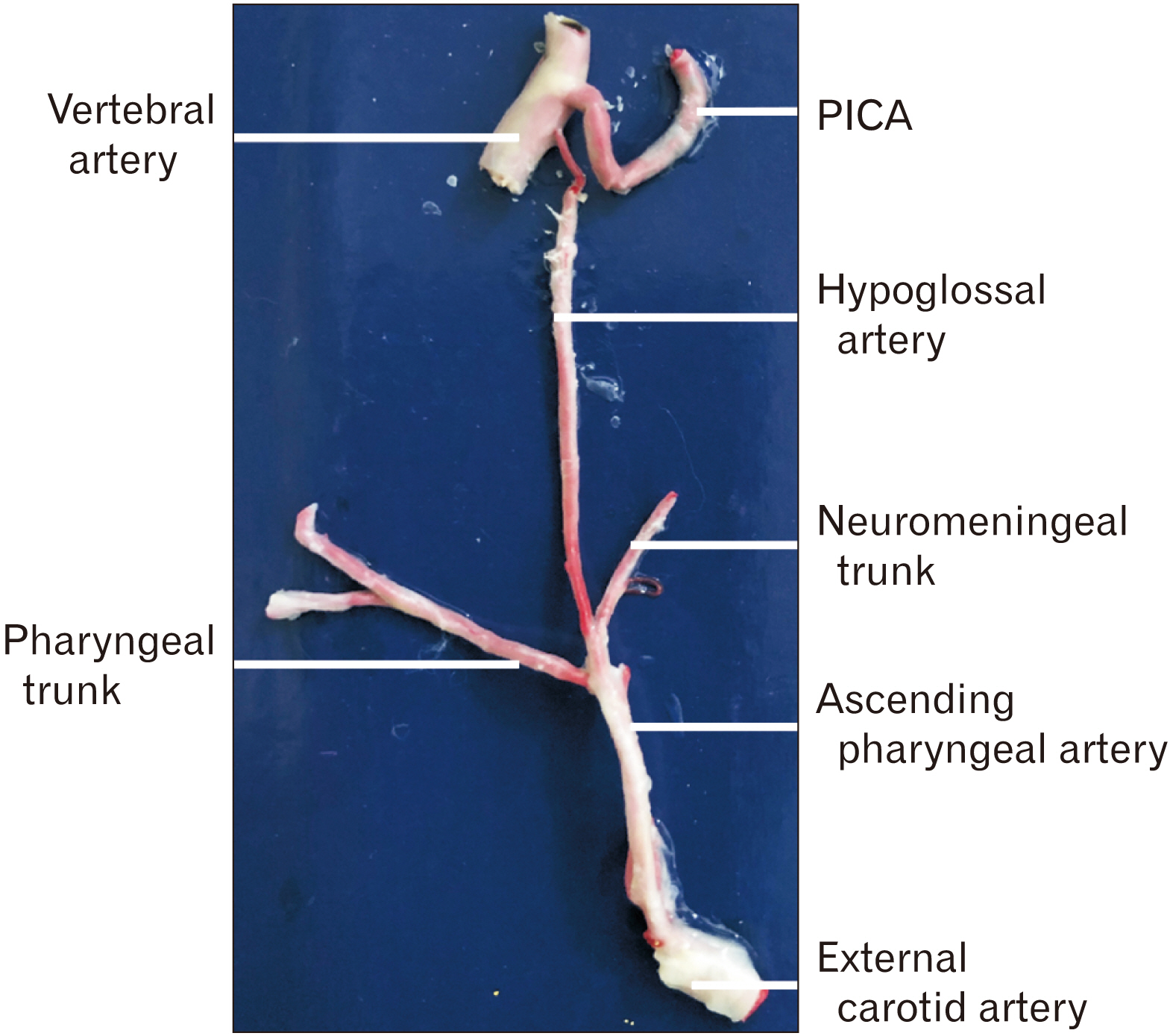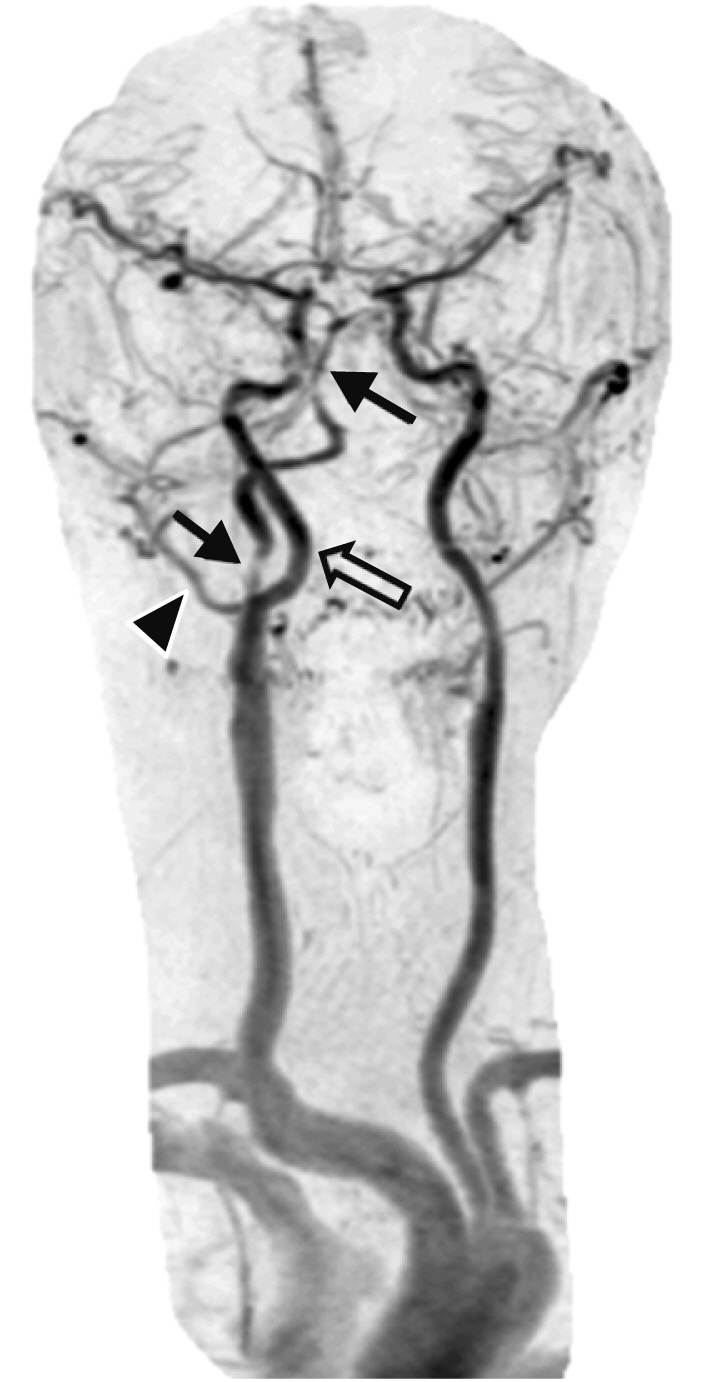Anat Cell Biol.
2021 Sep;54(3):399-403. 10.5115/acb.21.093.
Rare anastomosis between the ascending pharyngeal and vertebral arteries via the hypoglossal canal: A cadaveric case report
- Affiliations
-
- 1Department of Surgery, Louisiana State University, New Orleans, LA, USA.
- 2Division of Vascular and Endovascular Surgery, Department of Surgery, Tabriz University of Medical Sciences, Tabriz, Iran.
- 3Department of Neurosurgery, Tulane University School of Medicine, New Orleans, LA, USA.
- 4Department of Neurology, Tulane University School of Medicine, New Orleans, LA, USA.
- 5Division of Gross and Clinical Anatomy, Department of Anatomy, Kurume University School of Medicine, Kurume, Fukuoka, Japan.
- 6Department of Anatomical Sciences, St. George's University, St. George's, Grenada.
- 7Department of Surgery, Tulane University School of Medicine, New Orleans, LA, USA.
- 8Department of Structural and Cellular Biology, Tulane University School of Medicine, New Orleans, LA, USA.
- 9Department of Neurosurgery, Ochsner Neuroscience Institute, Ochsner Health System, New Orleans, LA, USA.
- 10Queensland University, Brisbane, Australia.
- KMID: 2521053
- DOI: http://doi.org/10.5115/acb.21.093
Abstract
- We present a rare case of external carotid artery-vertebral artery anastomosis via the ascending pharyngeal artery, diagnosed upon cadaveric dissection. The ascending pharyngeal artery gave rise to a branch to the hypoglossal canal, which is a variation of a true persistent fetal hypoglossal artery. Knowledge of persistent carotid-vertebrobasilar anastomoses is important as these fetal vessels can contribute significantly to the posterior cerebral circulation. Only 10 cases of external carotid artery-vertebrobasilar artery anastomoses have been reported to our knowledge, and our case presents the first cadaveric dissection of this rare variation.
Keyword
Figure
Reference
-
References
1. inivas MR Sr, Vedaraju KS, Manjappa BH, Nagaraj BR. 2016; Persistent primitive hypoglossal artery (PPHA) - a rare anomaly with literature review. J Clin Diagn Res. 10:TD13–4. DOI: 10.7860/JCDR/2016/15556.7116. PMID: 26894148. PMCID: PMC4740676.2. Uchino A, Saito N, Okada Y, Kozawa E, Nishi N, Mizukoshi W, Inoue K, Nakajima R, Takahashi M. 2013; Persistent hypoglossal artery and its variants diagnosed by CT and MR angiography. Neuroradiology. 55:17–23. DOI: 10.1007/s00234-012-1074-0. PMID: 22821359.
Article3. Uchino A, Saito N, Kurita H. 2018; Anastomosis of the external carotid artery and the V3 segment of the vertebral artery (presumed persistent second cervical intersegmental artery) diagnosed by CT angiography. Surg Radiol Anat. 40:233–6. DOI: 10.1007/s00276-017-1906-z. PMID: 28765987.
Article4. Yamamoto R, Mori N, Nakae Y, Tanaka F, Johkura K. 2019; Anomalous anastomosis between the external carotid artery and vertebrobasilar artery via the hypoglossal canal: a case report and review of literature. Surg Radiol Anat. 41:849–52. DOI: 10.1007/s00276-019-02205-y. PMID: 30729985.
Article5. Brismar J. 1976; Persistent hypoglossal artery, diagnostic criteria. Report of a case. Acta Radiol Diagn (Stockh). 17:160–6. DOI: 10.1177/028418517601700204. PMID: 1274653.6. Hacein-Bey L, Daniels DL, Ulmer JL, Mark LP, Smith MM, Strottmann JM, Brown D, Meyer GA, Wackym PA. 2002; The ascending pharyngeal artery: branches, anastomoses, and clinical significance. AJNR Am J Neuroradiol. 23:1246–56. PMID: 12169487. PMCID: PMC8185735.7. Iwanaga J, Simonds E, Choi PJ, Oskouian RJ, Tubbs RS. 2018; Anatomical study of the posterior ascending artery: application to C2 pedicle screw placement. World Neurosurg. 112:e662–5. DOI: 10.1016/j.wneu.2018.01.118. PMID: 29374610.
Article8. Uchino A, Saito N. 2011; Persistent hypoglossal artery arising from the external carotid artery diagnosed by MR angiography. Surg Radiol Anat. 33:543–5. DOI: 10.1007/s00276-010-0769-3. PMID: 21203762.
Article9. Lasjaunias P, Théron J, Moret J. 1978; The occipital artery. Anatomy-normal arteriographic aspects-embryological significance. Neuroradiology. 15:31–7. DOI: 10.1007/BF00327443. PMID: 643171.10. Okahara M, Kiyosue H, Mori H, Tanoue S, Sainou M, Nagatomi H. 2002; Anatomic variations of the cerebral arteries and their embryology: a pictorial review. Eur Radiol. 12:2548–61. DOI: 10.1007/s00330-001-1286-x. PMID: 12271398.
Article11. Ascher E, Hingorani A, Markevich N, Schutzer R, Yorkovich WR, Kallakuri S, Tsemekhim B. 2003; Carotid surgery without external carotid endarterectomy: a 6-year clinical experience with 1027 cases. Eur J Vasc Endovasc Surg. 25:458–61. DOI: 10.1053/ejvs.2002.1867. PMID: 12713786.
Article12. Iwanaga J, Singh V, Ohtsuka A, Hwang Y, Kim HJ, Moryś J, Ravi KS, Ribatti D, Trainor PA, Sañudo JR, Apaydin N, Şengül G, Albertine KH, Walocha JA, Loukas M, Duparc F, Paulsen F, Del Sol M, Adds P, Hegazy A, Tubbs RS. 2021; Acknowledging the use of human cadaveric tissues in research papers: recommendations from anatomical journal editors. Clin Anat. 34:2–4. DOI: 10.1002/ca.23671. PMID: 32808702.
Article
- Full Text Links
- Actions
-
Cited
- CITED
-
- Close
- Share
- Similar articles
-
- Angiographic Demonstration of External Carotid-Vertebral Arteries Anastomosis
- A case of primitive persistent hypoglossal artery
- Intracranial Hypoglossal Neurinoma: A Case Report
- Resolution of Isolated Unilateral Hypoglossal Nerve Palsy Following Microvascular Decompression of the Intracranial Vertebral Artery
- A Case of Facial-Hypoglossal Anastomosis







